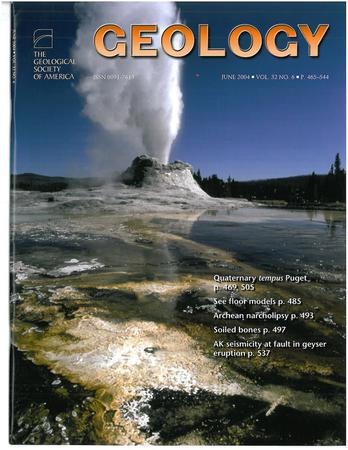Neoarchean synkinematic metamorphic peak in the Isua supracrustal belt (West Greenland)
IF 4.8
1区 地球科学
Q1 GEOLOGY
引用次数: 0
Abstract
We present petrological data and seven Lu-Hf garnet−amphibole−whole rock ages obtained from a single garnet-hornblende-mica schist sample from the Isua supracrustal belt (West Greenland). Garnets grew during prograde metamorphism toward regional amphibolite-facies peak conditions, and a mylonitic foliation formed during and after garnet growth. Garnet crystals show typical prograde zoning with no visible traces of a relict garnet generation. They do show various degrees of retrogression. While some crystals are perfectly euhedral with only minor chemical alteration along cracks, others are elongated in the foliation and either grew in this shape or were deformed. Six garnet splits were separated from crushed single crystals and one from a crushed bulk sample. Individual three-point garnet−hornblende−whole rock ages scatter between 2.603 ± 0.018 Ga and 2.432 ± 0.059 Ga for single garnets. The garnet split from the bulk sample defines an age of 2.463 ± 0.031 Ga, the data point farthest from the regression line for all data points (2.551 ± 0.074 Ga, mean square of weighted deviates = 25). We interpret these data to indicate partial retrogression of a Neoarchean garnet population not significantly older than the oldest obtained three-point age. Well-preserved garnet zoning, regional peak temperatures well below the closing temperature of the Lu-Hf system, and the small scatter of Lu-Hf ages preclude an interpretation of the observed metamorphism and deformation as being Eoarchean in age.西格陵兰岛伊苏亚上地壳带新太古代同动变质峰
我们提供了岩石学数据和七个Lu-Hf石榴石-角闪石-全岩年龄,这些年龄是从Isua表壳带(西格陵兰)的单个石榴石-角闪云母片岩样品中获得的。石榴石在区域角闪岩相峰值条件下的进变质作用期间生长,在石榴石生长期间和之后形成糜棱岩叶理。石榴石晶体显示出典型的前进分带,没有可见的残余石榴石生成痕迹。他们确实表现出不同程度的倒退。虽然一些晶体是完全自形的,沿着裂缝只有轻微的化学变化,但其他晶体在叶理中被拉长,要么生长成这种形状,要么变形。从破碎的单晶中分离出六个石榴石裂缝,从破碎的大块样品中分离出一个。单个三点石榴石-角闪石-全岩年龄分布在2.603±0.018 Ga和2.432±0.059 Ga之间。从大块样品中分离出的石榴石定义了2.463±0.031 Ga的年龄,这是所有数据点离回归线最远的数据点(2.551±0.074 Ga,加权偏差的均方=25)。我们对这些数据的解释表明,新太古代石榴石种群的部分退化并不明显大于获得的最古老的三点年龄。保存完好的石榴石分带,区域峰值温度远低于Lu-Hf系统的闭合温度,以及Lu-Hf年龄的小范围分散,排除了将观察到的变质作用和变形解释为年龄上的始太古代。
本文章由计算机程序翻译,如有差异,请以英文原文为准。
求助全文
约1分钟内获得全文
求助全文
来源期刊

Geology
地学-地质学
CiteScore
10.00
自引率
3.40%
发文量
228
审稿时长
6.2 months
期刊介绍:
Published since 1973, Geology features rapid publication of about 23 refereed short (four-page) papers each month. Articles cover all earth-science disciplines and include new investigations and provocative topics. Professional geologists and university-level students in the earth sciences use this widely read journal to keep up with scientific research trends. The online forum section facilitates author-reader dialog. Includes color and occasional large-format illustrations on oversized loose inserts.
 求助内容:
求助内容: 应助结果提醒方式:
应助结果提醒方式:


